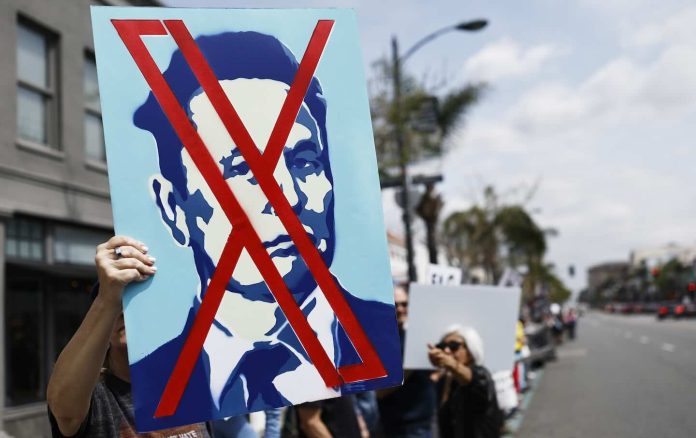Activism
/
March 31, 2025
I went to a #TeslaTakedown in New York and signed on to a Zoom “Resistance Lab” training. Here’s what I saw.
Protesters demonstrate against Tesla CEO Elon Musk’s Department of Government Efficiency (DOGE) initiatives during a nationwide “Tesla Takedown” rally outside a Tesla dealership on March 29, 2025, in Pasadena, California.
(Mario Tama / Getty Images)
My friend and fellow Nation contributor Micah Sifry, like many of us, has been looking for the right word for the anti-Trump movement 2.0. He never loved “resistance” because he thought it exaggerated our troubles (and heroism) by comparing us to people who fought Nazism. (Some bros associate it with “Wine Moms” aka Hillary Clinton supporters, but neither he nor I truck with that.) Some advocate using the word “opposition” this time around, but with so many elected Democrats, in the supposed opposition party, caving to Trump and copresident Elon Musk, that doesn’t entirely work either.
Sifry likes the term “defiance,” and so do I.
His Substack, The Connector, is must-reading in this era of defiance. For one thing, he reports on the growing anti-Trump, anti-Elon Musk protests, while pundits merely opine. Against a backdrop of jaded Beltway reporters insisting that anti-Trump forces lack energy, he cites research by Erica Chenoweth and others showing there has been much more activism since Inauguration Day than there was at this time in 2017. Sifry charts the hundreds of protests sponsored by groups of laid-off or threatened federal workers like Resistance Rangers and letter carriers. (Really, you should subscribe.)
He also reports, based on his long history of covering upstart movements, that the ongoing #TeslaTakedown protests—during which folks gather outside various Tesla sites, mostly dealerships—are for real, and not simply a fun daylong diversion. They’ve been organized by a range of activism veterans like New York’s Alice Hu, actor/activist Alex Winter, and Annie Wu Henry, a veteran of Swifties for Harris and John Fetterman’s innovative social media campaign back when he was a progressive. The first Manhattan protest was spearheaded by a lone woman and a friend who took a video of her (I haven’t been able to find out her name) on February 4. So I went out to cover the biggest one yet in Manhattan on Saturday, part of a “global day of action” that drew tens of thousands of protesters to 253 Tesla sites.

It started at noon, but when I arrived at 12:20 pm, Washington Street between 14th and 13th (in the touristy Meatpacking District) was jam-packed, and the NYPD had already blocked off traffic on 13th Street. (There were also guards outside Rolex and Gucci down the street.) Eventually the jubilant, noisy crowd spilled south towards 12th Street. I’d say it was at least 1,000 people at its height.
It was 80 degrees though windy, generally a great early spring day for a protest. Amazon workers in their blue and yellow vests turned out, so did parents with baby strollers and dozens of dogs, in backpacks and on leashes, including one who wore a “Dogs against DOGE” sign.
The demonstration was enlivened by an influx from a nearby march celebrating the 38th anniversary of the ACT UP movement, which got long-delayed attention, and funding, from the federal government for HIV and AIDS research and treatment back in the late 1980s. To this day, it’s probably the most successful mass protest movement since the 1960s civil rights mobilization. Pink triangles were everywhere.
Many of the ACT UP contingent were younger people and trans people—not at all surprising given the threats they face under Trump. At one point activists did a “die-in,” right at the Tesla entrance. I was too far away to see it, but folks around them raised “gravestones” with protest slogans. “DOGE Is Killing Medicaid,” one read. Others said DOGE was killing AIDS research and PEPFAR, the George W. Bush program that saved millions of lives in Africa (more than those killed by his unnecessary Iraq War). There were a lot of signs warning of threats to Social Security and Medicare in the crowd. A disproportionate share of protesters came from the demographic that cares about that most—meaning mine.
A woman of my demographic then sat down next to me, taking a short break for a moment. Retiree Linda Stevens said it was her first anti-Trump protest of any kind this time around. “I felt like I needed to take some kind of action instead of reading The New York Times and deploring things,” she told me. “All rationality has been thrown to the wind.” She marveled at the range of protest signs and T-shirts, ranging from “Beto for Senate” to “Park Rangers United” to “Third Act” to many different labor unions. “There’s just so much to protest,” she marveled. Then she got up to rejoin the crowd.
The two most visible signs, banners hoisted by multiple people, included a popular one reading “Would Have Fought The Nazis? Now’s Your Chance.” More divisive was “Burn a Tesla. Save Democracy.” That kind of rhetoric, backed by very rare vandalism against Tesla, have led whiny man-baby Musk to call such moves “domestic terrorism.” Backed by Attorney General Pam Bondi, that could lead even to peaceful protests, conceivably, being criminalized. But there was no vandalism on Saturday. (A few people were arrested at this site for property damage two weeks ago.) The only slightly divisive moment came when a contingent began adding “Free, Free, Free Palestine” to other chants. A group of four older people filed past me to leave at that point. “You just lost me,” one man said. “Me too,” said a female companion.
That was the only topic debated on a #TeslaTakedown message board that I saw after the group dispersed. Most of the 10 people (only 10) writing about it on the message board complained about adding that demand to the demonstration; one argued that with Trump snatching pro-Palestinian protesters off the streets without due process, a robust anti-Trump movement can’t ignore the issue. I’m just the reporter here.
Despite reports of DOGE counterprotests planned for the day, I only saw a handful of isolated counterprotesters in Manhattan. (In Idaho, Oregon and Fresno, California, an assortment of Proud Boys, militia members, and one guy dressed like Hitler showed up, but they were outnumbered by takedown supporters.) In Manhattan, a fashed-up, bulked-up guy in tight black clothing, taking photos of the crowd on his iPhone, clashed with an older anti-Trump protester, but both police and other members of the crowd separated them quickly. An earnest teen in a Green Bay Packers cap accosted someone carrying a pro-trans-rights sign, telling him that “most” trans people regret transitioning (it’s a tiny but well-documented minority), so he’s actually the one championing trans rights. Remarkably, people in the crowd argued rationally with the child. They’re better than me.
Given the rise and spread of anti-Trump, anti-Musk protest, as well as the attacks on those who resist, Representative. Pramila Jayapal designed a “Resistance Lab,” to train people in the principles of nonviolent resistance, as we see institutions from universities to giant law firms to mainstream media companies capitulate to Trump’s threats, while Democrats dither in Congress, and Republicans continue selling their souls to Trump.
-
Pramila Jayapal: “We Have to Stand Up and Fight Back”
I attended the Zoom meeting on Sunday, where I was joined by at least 1,300 attendees from 31 states and three countries (Canada and Austria). That number far exceeded the 500 people who showed up in person in Seattle on March 22.
“We want to help you seed and coordinate these nonviolent resistance actions,” Jayapal told Zoom, “And to be able to understand your risk tolerance,” as the risk of Trump cracking down on other forms of protest escalates.

She introduced Erica Chenoweth, whose research into the surprisingly robust anti-Trump defiance I noted above has helped people feel their own power, Jayapal said. “I wake up every morning with the same anxiety you do,” Chenoweth confessed. But the growing activism she sees steels her spine. Nevertheless, what she called “a global democratic recession” every year for the last 17 years has been weakening democracy worldwide, reducing the number of countries that are democratic and elevating autocracy. In 2024 that trend accelerated with the anti-incumbent wave that gave us Trump 2.0. In March, Monty Marshall of the Polity Project downgraded the United States from a democracy to a “non-democracy,” due to what he called an “executive coup,” and a “total lack of checks and balances of the executive.” Examples range from dismantling congressionally mandated agencies like USAID, attacks on science and universities, attempts to erase civil rights with anti-DEI measures, and the accelerating arrests and deportations of non-U.S. citizens either allegedly here illegally or here legally but who have exercised their civil rights in ways that Trump deplores, such as pro-Palestinian students Mahmoud Khalil and Rumeysa Ozturk.
The lesson from struggles elsewhere, she said, is that “institutions alone don’t save us.” From Poland to South Africa to Chile to the Jim Crow South to 2024 South Korea, Chenoweth said, “successful pro-democracy movements have relied on “strong and sustained grassroots and grasstops mobilization,” adding “every tyrant is dependent on the cooperation and obedience and help of thousands of people…autocratic power is extremely fragile.” She outlined the five-segment spectrum of political opinion in the US from “active opposition” to the anti-Trump movement to “active allies,” with passive and neutral folks in between, and said the secret to building a successful resistance is to nudge each group a little bit to the left, a little bit away from the autocrat. But to do that, she said, these movements need to get pretty big and develop momentum. Still, global studies show that mobilizing just 3.5 percent of the population against the authoritarian leader, in this case Trump, can topple the regime.
Popular
“swipe left below to view more authors”Swipe →
Current Issue

Movements have to maintain “resilience and discipline,” she warned, in the face of violence, which she predicted will escalate here. “That means having a plan for nonviolent resistance as well as noncooperation.” Chenoweth ended by pointing to the emotions that mobilize people (“anger and hope, together”) and those that demobilize people (“fear and a sense of powerlessness,” in particular), and closed with: “You’re not alone, and you don’t need to do anything alone.”
Jayapal then walked through the principles of nonviolence, heavily based on the US civil rights movement, and how to deploy it against a rising tide of repression that is only certain to grow. She outlined ways of “raising the costs on perpetrators” of anti-resistance violence that can ultimately backfire on autocrats.
You can find Chenoweth and Jayapal’s talks and slide presentations here; they’re incredibly useful whether you want to just watch, to read through, or to get organized. To me, the most important stuff came out of the small focus groups. People began planning “die-ins” at their local Social Security offices, posting billboards in red areas educating people about Social Security and Medicare cuts (again, a lot of seniors here), and expanding messaging to convince Americans that “this is about all of us,” as in almost every American except the super-wealthy will be hurt by the Trump-Musk autocracy.
Is this enough “defiance”? Of course not. But Jayapal and Sifry agree that it will not be enough to rely on the courts, or to channel people exclusively toward, say, the 2026 midterms (




